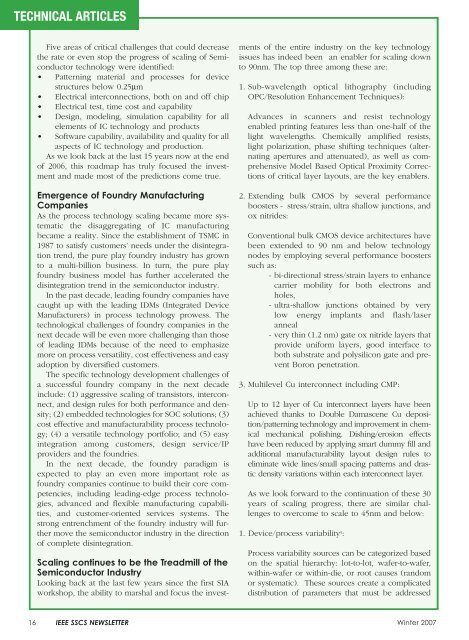The Impact of Dennard's Scaling Theory - IEEE
The Impact of Dennard's Scaling Theory - IEEE
The Impact of Dennard's Scaling Theory - IEEE
- TAGS
- scaling
- www.ieee.org
Create successful ePaper yourself
Turn your PDF publications into a flip-book with our unique Google optimized e-Paper software.
TECHNICAL ARTICLES<br />
Five areas <strong>of</strong> critical challenges that could decrease<br />
the rate or even stop the progress <strong>of</strong> scaling <strong>of</strong> Semiconductor<br />
technology were identified:<br />
• Patterning material and processes for device<br />
structures below 0.25μm<br />
• Electrical interconnections, both on and <strong>of</strong>f chip<br />
• Electrical test, time cost and capability<br />
• Design, modeling, simulation capability for all<br />
elements <strong>of</strong> IC technology and products<br />
• S<strong>of</strong>tware capability, availability and quality for all<br />
aspects <strong>of</strong> IC technology and production.<br />
As we look back at the last 15 years now at the end<br />
<strong>of</strong> 2006, this roadmap has truly focused the investment<br />
and made most <strong>of</strong> the predictions come true.<br />
Emergence <strong>of</strong> Foundry Manufacturing<br />
Companies<br />
As the process technology scaling became more systematic<br />
the disaggregating <strong>of</strong> IC manufacturing<br />
became a reality. Since the establishment <strong>of</strong> TSMC in<br />
1987 to satisfy customers’ needs under the disintegration<br />
trend, the pure play foundry industry has grown<br />
to a multi-billion business. In turn, the pure play<br />
foundry business model has further accelerated the<br />
disintegration trend in the semiconductor industry.<br />
In the past decade, leading foundry companies have<br />
caught up with the leading IDMs (Integrated Device<br />
Manufacturers) in process technology prowess. <strong>The</strong><br />
technological challenges <strong>of</strong> foundry companies in the<br />
next decade will be even more challenging than those<br />
<strong>of</strong> leading IDMs because <strong>of</strong> the need to emphasize<br />
more on process versatility, cost effectiveness and easy<br />
adoption by diversified customers.<br />
<strong>The</strong> specific technology development challenges <strong>of</strong><br />
a successful foundry company in the next decade<br />
include: (1) aggressive scaling <strong>of</strong> transistors, interconnect,<br />
and design rules for both performance and density;<br />
(2) embedded technologies for SOC solutions; (3)<br />
cost effective and manufacturability process technology;<br />
(4) a versatile technology portfolio; and (5) easy<br />
integration among customers, design service/IP<br />
providers and the foundries.<br />
In the next decade, the foundry paradigm is<br />
expected to play an even more important role as<br />
foundry companies continue to build their core competencies,<br />
including leading-edge process technologies,<br />
advanced and flexible manufacturing capabilities,<br />
and customer-oriented services systems. <strong>The</strong><br />
strong entrenchment <strong>of</strong> the foundry industry will further<br />
move the semiconductor industry in the direction<br />
<strong>of</strong> complete disintegration.<br />
<strong>Scaling</strong> continues to be the Treadmill <strong>of</strong> the<br />
Semiconductor Industry<br />
Looking back at the last few years since the first SIA<br />
workshop, the ability to marshal and focus the invest-<br />
ments <strong>of</strong> the entire industry on the key technology<br />
issues has indeed been an enabler for scaling down<br />
to 90nm. <strong>The</strong> top three among these are:<br />
1. Sub-wavelength optical lithography (including<br />
OPC/Resolution Enhancement Techniques):<br />
Advances in scanners and resist technology<br />
enabled printing features less than one-half <strong>of</strong> the<br />
light wavelengths. Chemically amplified resists,<br />
light polarization, phase shifting techniques (alternating<br />
apertures and attenuated), as well as comprehensive<br />
Model Based Optical Proximity Corrections<br />
<strong>of</strong> critical layer layouts, are the key enablers.<br />
2. Extending bulk CMOS by several performance<br />
boosters - stress/strain, ultra shallow junctions, and<br />
ox nitrides:<br />
Conventional bulk CMOS device architectures have<br />
been extended to 90 nm and below technology<br />
nodes by employing several performance boosters<br />
such as:<br />
- bi-directional stress/strain layers to enhance<br />
carrier mobility for both electrons and<br />
holes,<br />
- ultra-shallow junctions obtained by very<br />
low energy implants and flash/laser<br />
anneal<br />
- very thin (1.2 nm) gate ox nitride layers that<br />
provide uniform layers, good interface to<br />
both substrate and polysilicon gate and prevent<br />
Boron penetration.<br />
3. Multilevel Cu interconnect including CMP:<br />
Up to 12 layer <strong>of</strong> Cu interconnect layers have been<br />
achieved thanks to Double Damascene Cu deposition/patterning<br />
technology and improvement in chemical<br />
mechanical polishing. Dishing/erosion effects<br />
have been reduced by applying smart dummy fill and<br />
additional manufacturability layout design rules to<br />
eliminate wide lines/small spacing patterns and drastic<br />
density variations within each interconnect layer.<br />
As we look forward to the continuation <strong>of</strong> these 30<br />
years <strong>of</strong> scaling progress, there are similar challenges<br />
to overcome to scale to 45nm and below:<br />
1. Device/process variability 9:<br />
Process variability sources can be categorized based<br />
on the spatial hierarchy: lot-to-lot, wafer-to-wafer,<br />
within-wafer or within-die, or root causes (random<br />
or systematic). <strong>The</strong>se sources create a complicated<br />
distribution <strong>of</strong> parameters that must be addressed<br />
16 <strong>IEEE</strong> SSCS NEWSLETTER Winter 2007




